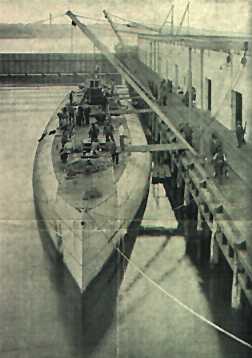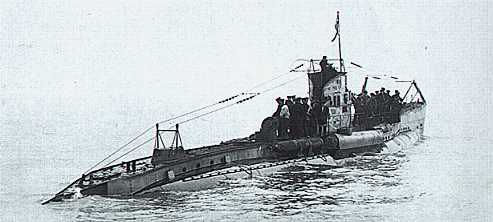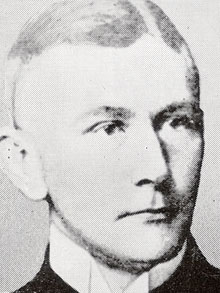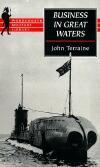In June 1916 the world saw another baffling debut in this war, which was so rich in "first time" episodes anyway: the debut of the first submarine for civilian use.
The unarmed submarine freighter Deutschland, skippered by Merchant Navy Captain Paul König, left Bremen and safely reached America (Baltimore, Maryland) in July with precious cargo. In August the freighter returned to Germany unharmed with a cargo ten times worth her building cost. In Autumn 1916 this stunning success was repeated with a return voyage from Bremen to New London, Connecticut.
After the declaration of unrestricted U-boat warfare in 1917, merchant submarines were no longer needed and so the Deutschland was commissioned as SM U 155 into the Imperial Navy.

The Deutschland in the port of New London
during the loading in November 1916
The next boat to cross the Atlantic, however, was not involved in such a peaceful mission. SM U-53 (Kptlt. Hans Rose) sank coolly just outside the three-mile-zone and in sight of American destroyers five ships - to demonstrate German naval power over the entire Atlantic. SM U-53's skilled commanding officer, Hans Rose, was considered to be one of the most humane U-boat skippers and there exist many reports of him caring for survivors even when putting his own boat at risk. For his achievements in the tonnage war he was awarded the Pour le mérite in 1917.
In October 1916 the U-boats returned to British waters with the obligation of applying prize rules. Despite this restrain, they sank 337,000 tons during this month, followed by 961,000 tons of shipping sunk between November 1916 and January 1917.
In February 1917, the German Admiral Staff was finally able to convince the Chancellor Bethmann-Hollweg to declare unrestricted U-boat warfare. Immediately the sinkings went up to 520,000 tons.
The harshness of this campaign was unnecessarily further driven home by two unhappy incidents, where two U-boats - SM U-55 (Kptlt. Wilhelm Werner) and SM U-44 (Kptlt. Paul Wagenführ) - were allegedly involved in the killing of survivors of ships - SS Torrington and SS Belgian Prince - they had sunk in April and July 1917. The worst case of these kinds of atrocities was supposed to have happened on 27 June, 1918, when SM U-86 (Oblt.z.S. Helmut Patzig), against international law and standing orders of the Imperial German Navy, sank the hospital ship LLandovery Castle. On top of that, he ordered his U-boat to ram the life boats and shot at the survivors. Of a crew of 258 of the LLandovery Castle only 24 survived. For this war crime, Patzig and his watch officers were tried after the war before a German court at Leipzig and were condemned to four years imprisonment.

SM U-86. Sank in two years 32 ships with a total of 119,411 tons.
The U-boat successes increased steadily in March (560,000 tons) and in April 1917, when the USA finally declared war on Germany, reached its peak with 860,000 tons. In May, however, the numbers of the sunk tonnage dropped to 616,000 tons, because the British Admiralty was finally able to convince itself to introduce the only really working counter measure against the U-boat threat: the convoy system. Of the 16,693 merchant vessels being escorted from May 1917 to November 1918 in one of the 1,134 convoys, 99% safely reached their destination. Although sinkings in June increased again to 696,000 tons, the drooping numbers of July (555,000 tons) were already foreshadowing the final outcome. It was the convoy system, which finally rendered the unrestricted campaign as unsuccessful and led to the defeat of Germany.
In June 1917, there was also a change in the German U-boat command structure: Commodore Andreas Michelsen, until then Commanding Officer of the Flandern Flotilla, was appointed "Befehlshaber der Unterseeboote" and Hermann Bauer was promoted to flag rank but retained his title as "Führer der Unterseeboote" in the High Seas Fleet. The two energetic officers soon drew up plans to carry the war across the Atlantic on America's very doorstep with a newly invented weapon: the undersea cruiser. These types of U-boats were capable of very long war patrols of several months and beside torpedoes equipped with heavy artillery - 15 cm and 8.8 cm guns. At first they used the converted merchant submarines of the Deutschland class (SM U 151 to 157) but later three large purpose built boats - SM U 139, U 140 and U 141 - joined the service, all commanded by very experienced officers, SM U 139 e.g. by the famous Lothar von Arnauld de la Periere.

SM U 139 "Kapitänleutnant Schwieger"
In the last nine months of the war, the cruisers roamed the entire Atlantic, laying mines off the North American Coast and sinking ships sailing alone. In May 1917, SM U 155, the former Deutschland, left port for the first patrol of a submarine cruiser. In 105 days it travelled over 9,000 miles, sank 19 ships and shelled targets ashore on the Azores. Further patrols followed at no enemy counter action, until in May 1918, SM U154 returning from patrol off Western Africa, was sunk by the British submarine HMS E35 off Cape Sao Vicente. SM U 151 (Korv.Kpt. Heinrich von Nostitz und Jänckendorff) performed a particularly remarkable 13 week patrol from May 1918, travelling over 9,700 miles. At the still peaceful coast of the USA, SM U 151 laid mines near important American ports and sank 23 ships (61,000 tons), strictly observing prize rules. The boat's First Watch Officer Kptlt. Friedrich Körner remembered:
"Far away from the battlefields, [at night] they sailed merrily with gleaming position lights, just like in peacetime."
The six operational cruisers which saw active service sank all in all 174 ships with a total of 361,000 tons.

SM UC 95 a type UC III U-boat for mining operations, after the end of war handed over to Great Britain
But the year 1917 - especially the winter of 1917/1918 - saw unhappy events for the German U-boat service as well, when a new mine barrier in the Channel closed this route effectively for U-boats and inflicted heavy losses on the German Flandern Flotilla.
See chapter 6. Finale.




